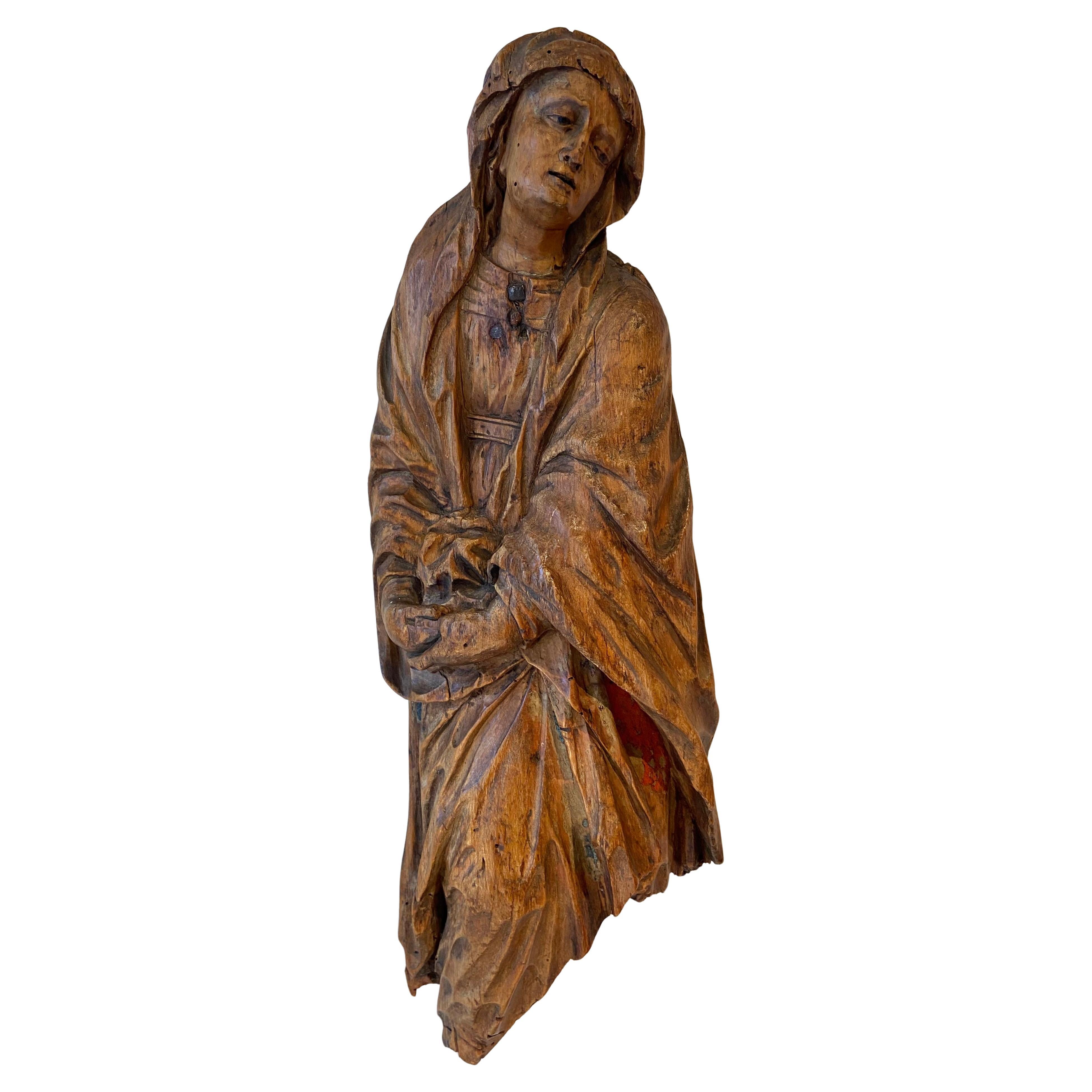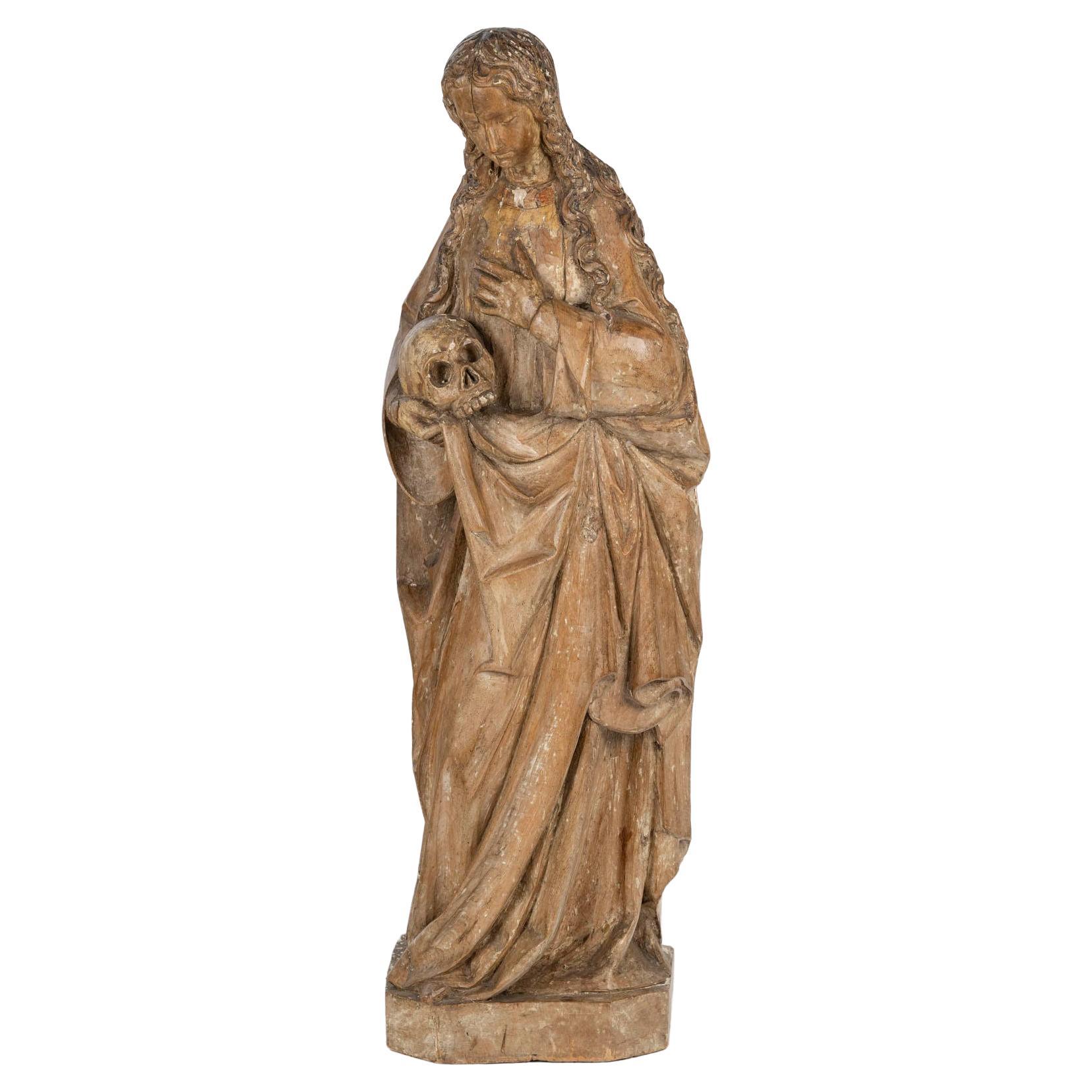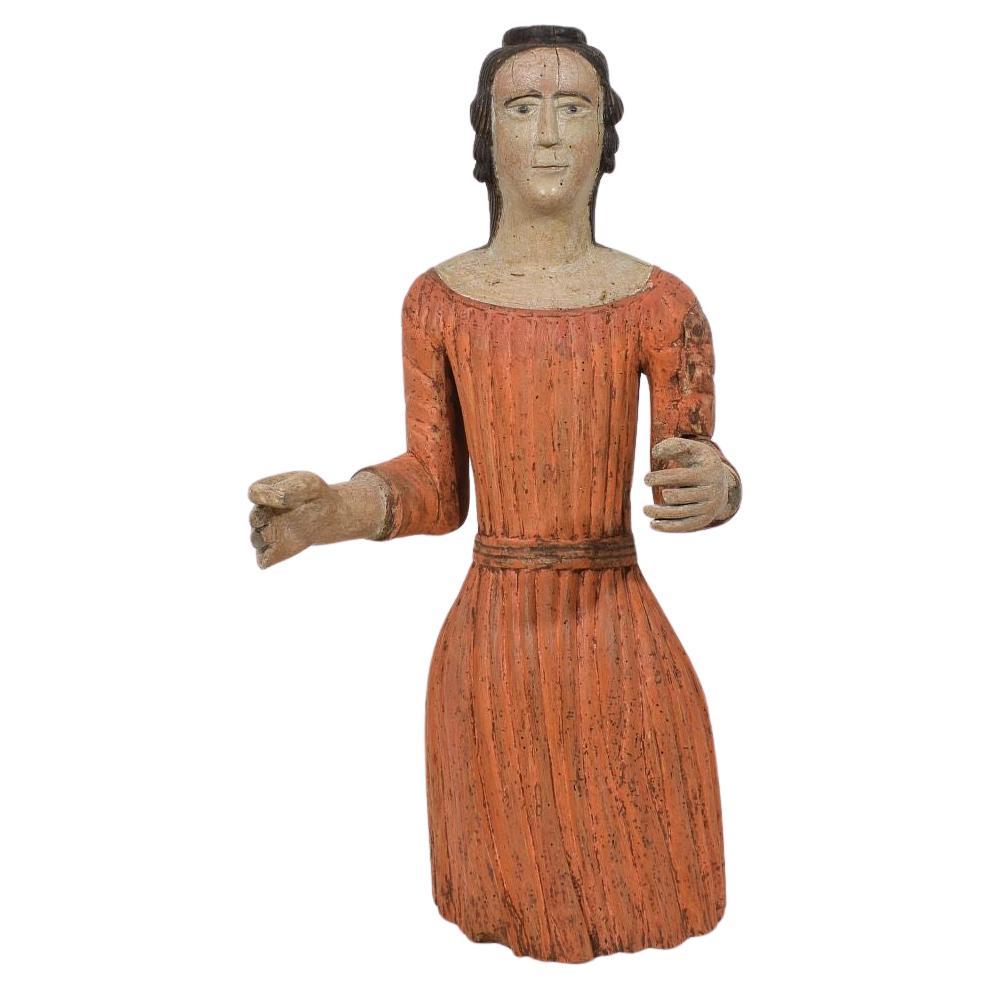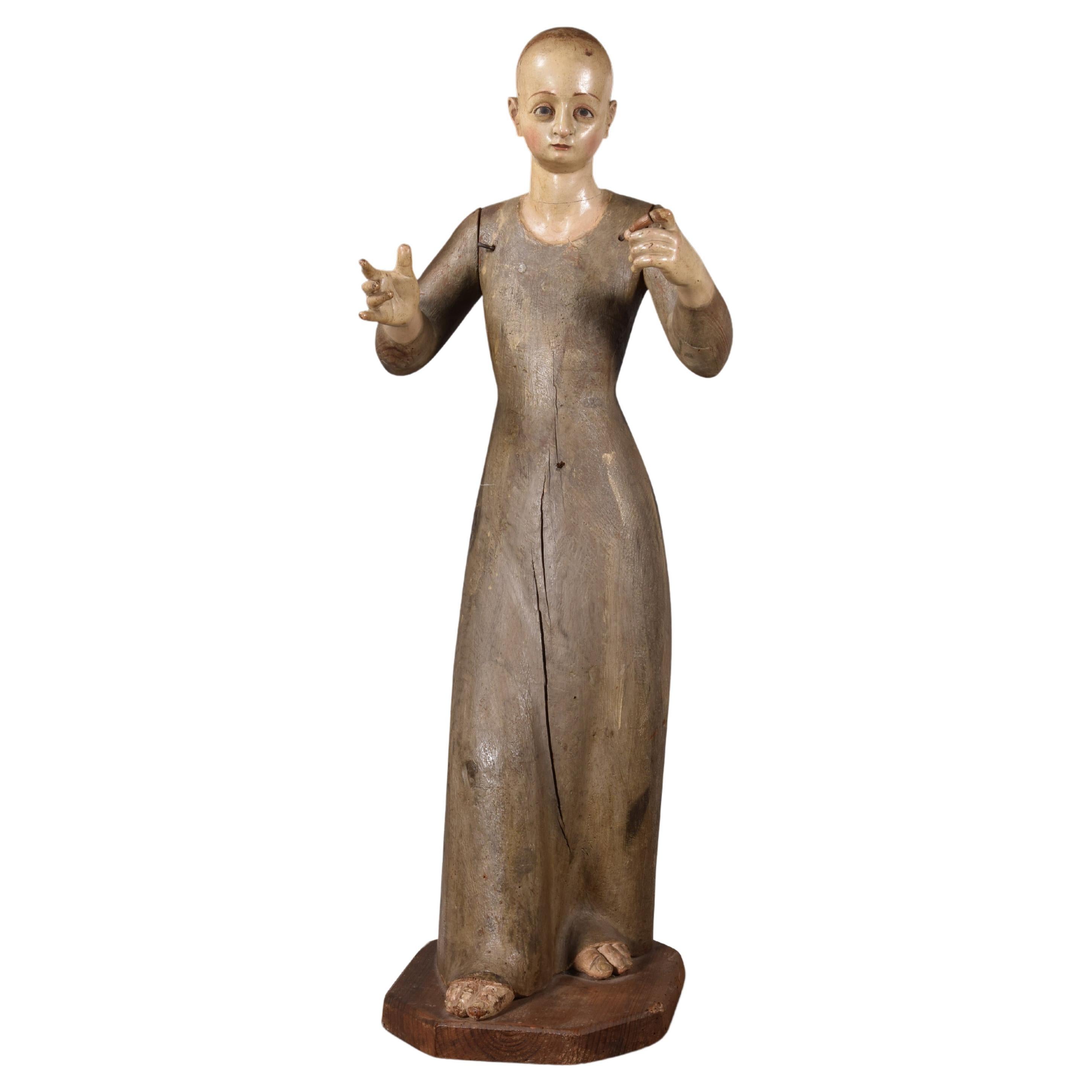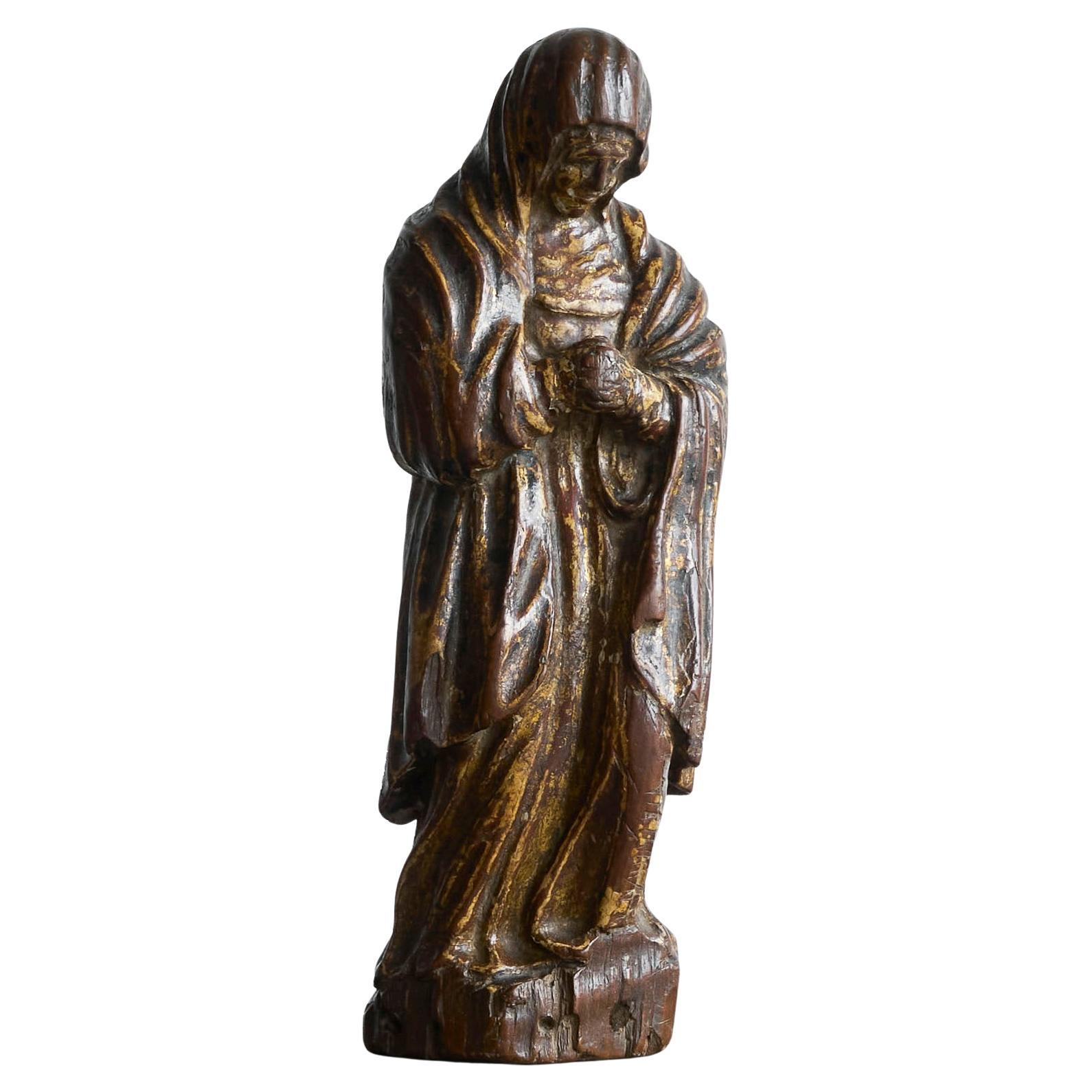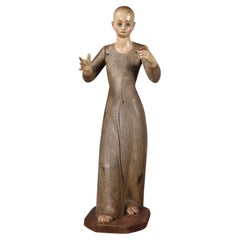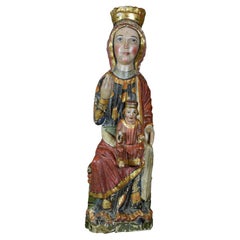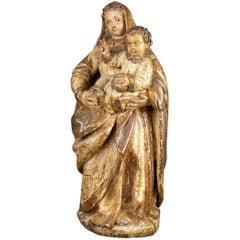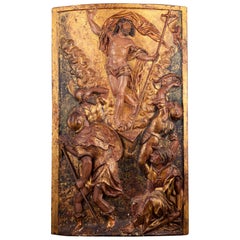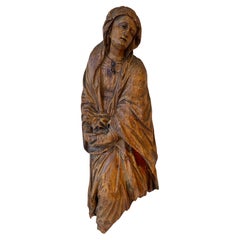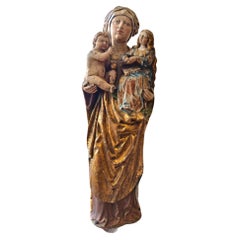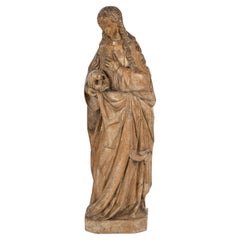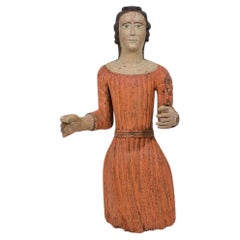Items Similar to Mary Magdalene on her way to Marseille. Castilian school, 15th century.
Want more images or videos?
Request additional images or videos from the seller
1 of 13
Mary Magdalene on her way to Marseille. Castilian school, 15th century.
$26,381.94
£19,625.50
€22,000
CA$36,125.89
A$40,167.08
CHF 20,973.03
MX$488,931.15
NOK 267,606.75
SEK 250,734.74
DKK 167,473.85
Shipping
Retrieving quote...The 1stDibs Promise:
Authenticity Guarantee,
Money-Back Guarantee,
24-Hour Cancellation
About the Item
Mary Magdalene on her way to Marseille. oil on board. Castilian school, towards the last third of the century XV. Oil on panel showing a landscape in the background with a walled city, some mountains and the shore of a watercourse (from the theme it is seen that it is the shore from sea). In the foreground and in full body, a boat with a sail appears with a circus richly dressed characters and with their respective nimbus (these decorated with geometric elements and engraved vegetables), two women and three men. Note the anecdotal detail of the fish crossing the waters under the ship. In the Golden Legend, chapter XCVI is dedicated to the figure of Mary Magdalene, including the journey that she performed together with Saint Maximinus, Lazarus, Martha, her of her servant Martila and San Cedonio ("the blind man from birth cured of his blindness by Christ), along with others Christians, for being expelled by the infidels who They lived in the region where they went to evangelize. They left the ship in the sea, without oars or sails or anything that she could help in the navigation with the idea that shipwrecked, but God saw to it that he reached Marseilles. The Catholic Christian tradition ended up giving end to this journey from the Holy Land in Saintes Maries de la Mer (near Arles), from where Maria Magdalena went to Marseille, undertaking the evangelization of Provence. Note that the characters represented here are Saint Mary Magdalena, as the main figure of the group, Saint Maximinus, Lazarus, Saint Cedonius and Martha. Some examples are known in which the Saint is seen accompanied by her, all the characters placed in a ship or related to it. It is not about, without However, from an iconography that is too frequent and will be even less common after the Council of Trent, as seem. Let us cite, as examples, the altarpiece of Pere Mates (Girona Cathedral Museum) from the 16th century with this legend (Provençal legend) in which the Santa already on land, with the boat in the background; figure entering the boat in Jean's altarpiece Béguin (Altarpiece of the Rosary of the Basilica of Saint Maximin in Var, France); she appears preaching in the port of Marseille in a painting by Ronzen (early 16th century, History Museum of Marseilles); in the Scrovegni Chapel in Padua Giotto painted the theme of the Miracle of the Governor of Marseille (topic related to this arrival) with figures in the boat and the governor's wife in the island; Magdalene Altarpiece by Lucas Moser (Church of Saint Mary Magdalene of Tiefenbronn). Stylistically, one can see in the painting a clear flamenco influence: note the details of the jewels of clothing, qualities, faces and naturalism sought in them (within the idealization that corresponds to the characters sacred), the landscape and the fortress of the background, etc. The influence of flamenco art in school Castilian began thanks to the patronage of the Mendoza, shortly after mid-century, and They also contributed to its development both growing relations with Flanders (it is necessary remember the journey of Jan van Eyck in 1427) as the import of flamenco works. Thus, the style Hispano-Flamenco achieved great development in the last quarter of the 15th century as regards the Kingdom of Castilla, with a series of smaller schools interconnected, thereby providing a certain character unitary to the art of this style in this geographical area. As for names (and remembering that there is a great number of anonymous works and authors of whom not we know data), we have what is considered the introducer, Jorge Inglés, and figures such as Fernando Gallego, focuses such as Valladolid and outstanding workshops like those of Burgos or Toledo. •
Measurements: 83x11x128 cm int 73x118 cm WEIGHT IS MERELY ORIENTATIVE, IT MAY VARY.
International Buyers – Please Note: for those articles that need Export Permits (those older than 100 years), the obtaining of the Permit will be processed without additional expenses (if you choose the seller sends it to you), but the period for the obtention of it may vary from 10 to 35 days.
- Dimensions:Height: 50.4 in (128 cm)Width: 32.68 in (83 cm)Depth: 4.34 in (11 cm)
- Style:Gothic (Of the Period)
- Materials and Techniques:
- Place of Origin:
- Period:
- Date of Manufacture:circa last third 15th century
- Condition:Wear consistent with age and use. Minor losses. Minor fading.
- Seller Location:Madrid, ES
- Reference Number:Seller: ZF10521stDibs: LU2951338493292
About the Seller
4.9
Vetted Professional Seller
Every seller passes strict standards for authenticity and reliability
Established in 1985
1stDibs seller since 2017
346 sales on 1stDibs
Typical response time: 8 hours
- ShippingRetrieving quote...Shipping from: MADRID, Spain
- Return Policy
Authenticity Guarantee
In the unlikely event there’s an issue with an item’s authenticity, contact us within 1 year for a full refund. DetailsMoney-Back Guarantee
If your item is not as described, is damaged in transit, or does not arrive, contact us within 7 days for a full refund. Details24-Hour Cancellation
You have a 24-hour grace period in which to reconsider your purchase, with no questions asked.Vetted Professional Sellers
Our world-class sellers must adhere to strict standards for service and quality, maintaining the integrity of our listings.Price-Match Guarantee
If you find that a seller listed the same item for a lower price elsewhere, we’ll match it.Trusted Global Delivery
Our best-in-class carrier network provides specialized shipping options worldwide, including custom delivery.More From This Seller
View AllSaint or Virgin to dress. Wood, metal. Spanish school, 17th century.
Located in Madrid, ES
Saint or Virgin to dress. Wood, metal. Spanish school, 17th century.
It has faults.
The female figure stands (with her right leg forward) on a small polygonal base. Made of partial...
Category
Antique 17th Century Spanish Baroque Religious Items
Materials
Metal, Other
Virgin with Child. Carved and polychrome wood. Spanish school, 13th century.
Located in Madrid, ES
Virgin with Child. Carved and polychrome wood. Spanish school, 13th century.
It has faults.
Polychrome wood carving that shows the Virgin sitting on a throne, with her right hand r...
Category
Antique 15th Century and Earlier Spanish Gothic Religious Items
Materials
Other
"Virgin with Child Jesus". Spain, End of the 17th-Early 18th Century
Located in Madrid, ES
Spanish Baroque sculpture is one of the most authentic and personal examples of our art, because its conception and its form of expression arose from the people and from the deepest ...
Category
Antique Late 17th Century Spanish Baroque Religious Items
Materials
Wood
“Ressurrection”, Polychromed Wood, Spanish School, 16th Century
Located in Madrid, ES
The relief was probably a door of the Sagrario. The piece follows a customary decoration in the tabernacles of the Renaissance and the Baroque. Compare, for example, with the sevente...
Category
Antique 16th Century Spanish Renaissance Religious Items
Materials
Other
"Madonna with Child and Angels". Italy, 15th-16th Centuries
Located in Madrid, ES
Bronze in its color and gold, lapis lazuli, rock crystal, enamel.
In the centre of the work is presented, enthroned, the figure of Mary, with a mantel (fireplace) on her shoulders and hair and holding on her knees the child, who appears addressing one of the angels. The virgin is also sheltered by an ogee arch supported on turned columns, and raised visually by steps. This composition achieves a very striking contrast: the dark bronze figure, in contrast to the lapis lazuli background and the part of the arch and the outside of it, in gilded bronze. Under the steps there is a heraldic enamel shield with a key on an azure background. The angels, kneeling, are flanking this figure, and, appearing in dark bronze, visually share the "category" of religious figures with Mary, while their (lower) position gives more status to both the Mother and Jesus. The rest of the composition is completed with a delicate landscape: constructions and walls on mountains, clouds in the sky, plants, stones, etc. To the outside, another lapis lazuli frame is placed decorated in the corners with appliques, giving way to carved and polychrome wood. The lapis lazuli is a semiprecious stone already known in the seventh millennium BC., found in deposits from the Caucasus to Mauritania. From the end of the middle ages, it increased its export to Europe, its use being more frequent since then both to use it as a pigment in paintings after grinding it (giving rise to the finest and most expensive of the blues, and of the colors in many occasions), as for backgrounds of paintings, incrustations in works of art, jewelry and, a little later, in the well-known "hard stone works". The figure of Mary still shows an influence of Gothic models, although more European than Italian, along with elements that could already show a closeness to the Renaissance: although the nakedness of Jesus is already shown in Gothic works (Madonna with Angels by Fra Angelico ), the creation of space by playing with the cloth in front of Christ can be appreciated in more advanced paintings (Virgin with Child by Domenico Ghirlandaio, National Gallery of London); the presence of a powerful throne can be seen frequently in Italian Madonnas of the Quattrocento (and before), but not quite as presented here. As for the landscape, it is necessary to compare it, for example, with that of the fresco of the Condotiero Guidoriccio de Fogliano (Simone Martini, finished in 1328). This is a work of great technical and aesthetic quality, not to mention the materials chosen for its creation, comparable only to outstanding examples from around the world, such as those preserved in the Palazzo Madama in Torino (Italy), where the coral It also has an important role. It is essential to mention, also, works such as the plate of hard stones (lapis lazuli between them) with a relief of Mary with the Child in...
Category
Antique 16th Century Italian Renaissance Religious Items
Materials
Lapis Lazuli, Bronze, Enamel, Other
Immaculate Conception. Wood, glass, silver. Portuguese school, 18th century.
Located in Madrid, ES
Immaculate Conception. Carved and polychrome wood, glass, silver. Portuguese school, 18th century.
Sculpture made of wood showing a young Mary, with her hands together in front of h...
Category
Antique 18th Century European Rococo Religious Items
Materials
Silver, Other
You May Also Like
Sculpture of Maria Magdalena, ca. 1600
Located in 'S-HERTOGENBOSCH, NL
Sculpture of Maria Magdalena in fruitwood, ca. 1600.
Probably The Netherlands or German. Remains of polychromy.
In the past the underside has been affected by moisture and wood rot....
Category
Antique Early 17th Century Dutch Renaissance Figurative Sculptures
Materials
Fruitwood
15th Century Gothic Virgin
Located in Madrid, ES
15th century Gothic Virgin
Gothic Virgin of the 15th century Virgin in carved and polychrome wood of the 15th century. In its original state, muse...
Category
Antique 15th Century and Earlier Figurative Sculptures
Materials
Wood
$20,985
Carved Wooden Sculpture of Mary Magdalene, Circa 1500.
Located in Saint-Ouen, FR
Carved wooden sculpture of Mary Magdalene, circa 1500.
Large limewood sculpture with traces of polychromy representing Mary Magdalene, German work, circa 1500.
H: 80cm. W: 35cm, D: ...
Category
Antique 16th Century German Figurative Sculptures
Materials
Wood
French Medieval Painted Wooden Madonna
Located in Buisson, FR
Unique and extremely rare medieval wooden Madonna with traces of her original color
Original period piece, South of France, circa 1500 or older
Weathered, small losses and old repair...
Category
Antique 16th Century French Medieval Religious Items
Materials
Wood
$3,297 Sale Price
50% Off
16th Century Mary Magdalene in Polychromed Carved Walnut
Located in Meer, VAN
Mary Magdalene in Polychromed Carved Walnut 16th Century
Devotional figure in carved wood, depicting Mary Magdalene. Walnut, most probably Flemish and from the 16th century.
It de...
Category
Antique 16th Century European Medieval Figurative Sculptures
Materials
Walnut
Saint Catherine of Alexandria
Located in Saint-Ouen, FR
SAINT CATHERINE OF ALEXANDRIA
ORIGIN : SWABIA, ULM REGION
PERIOD : ca. 1510-1520
Height : 118 cm
Length : 39 cm
Depth : 17 cm
Limewood...
Category
Antique 16th Century Figurative Sculptures
Materials
Wood
More Ways To Browse
15th Century Spanish
15th Century Panels
Antique Wood Saw
16th Century Dress
Spanish Wood Saint
Spanish Furniture 15th Century
Antique Wood Blinds
Spanish Wood Wall Panels
Wall Panel Gothic
Antique Catholic Church Items
Old Man Of The Sea
Castilian Furniture
Antique Rosaries
Antique Rosary Rosaries
Used Flamenco Dress
Circus Collectibles
Martha Dresses
Boat Oars
